Survey: ABC Members Say Government-Mandated Project Labor Agreements Harm Workforce Development Efforts
ABC members overwhelmingly reported that government-mandated project labor agreements harm their businesses, hiring and workforce development practices and ability to complete work safely, on time and on budget, according to the results of a December 2018 membership survey published last month.
Almost 97% of survey respondents said provisions in PLAs that would require their firm to hire most or all of their company’s apprentices from only union apprenticeship programs would harm their company’s investment in workforce development programs to address the industry’s skilled workforce shortage.
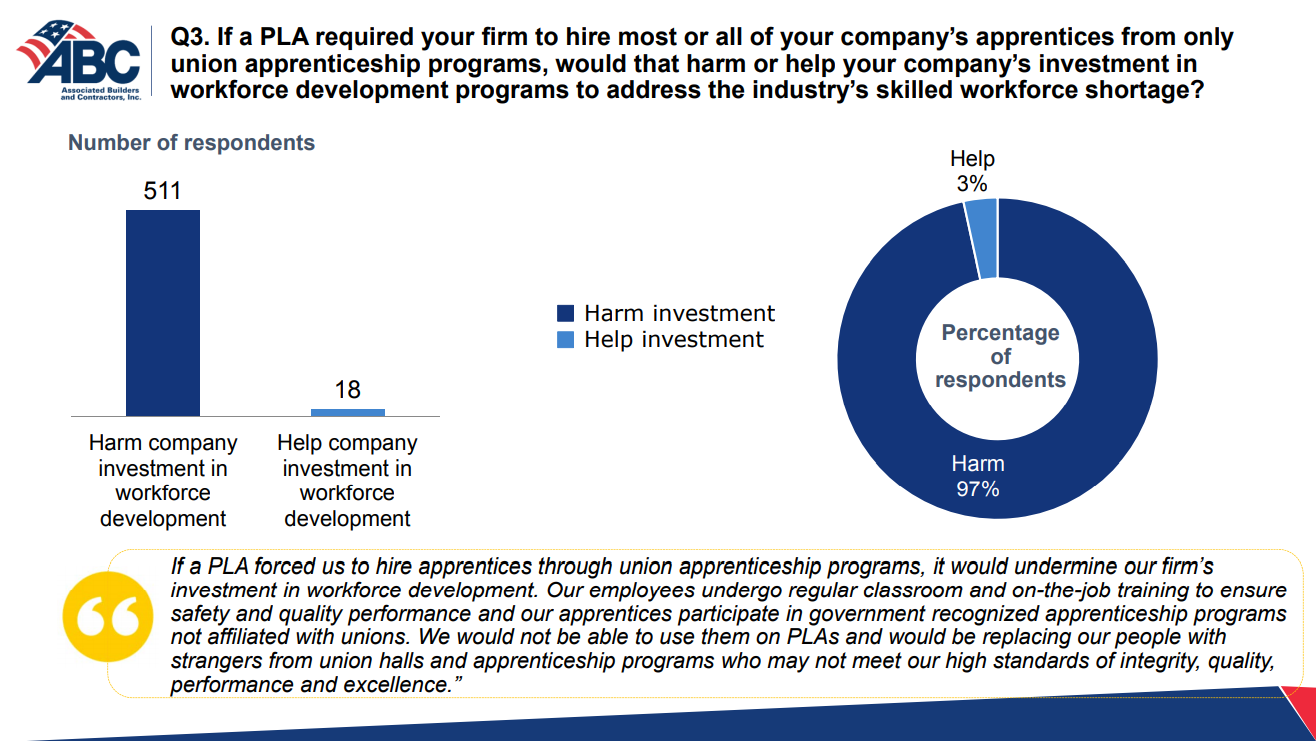
Despite the fact that more than 87% of the U.S. construction workforce chooses not to belong to a union, PLAs typically force contractors to hire most or all apprentices from union-affiliated apprenticeship programs, as outlined in the PLA or applicable union’s Collective Bargaining Agreement referenced in the PLA document.
For example, Article 13 of the PLA (pdf) mandated by lawmakers on the federally assisted District of Columbia’s South Capitol Street Corridor Project – Phase 1 has the following problematic apprenticeship language on page 42, which forces contractors to use apprentices affiliated with union programs instead of their own existing apprentices not affiliated with union programs:
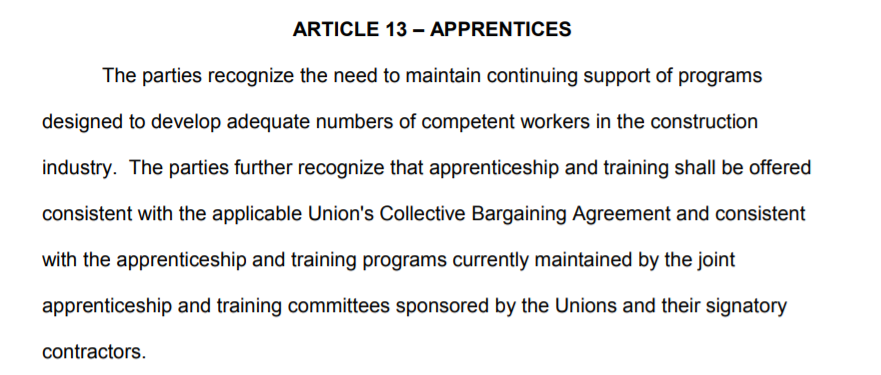
The Construction Industry Faces a Skilled Workforce Shortage of 500,000 Workers in 2019
ABC estimates that 8.2 million people were employed by the U.S. construction industry in 2018, and an additional 500,000 people need to be hired in 2019 to meet the current backlog of construction projects—which stood at to 8.8 months in February 2019, according to ABC’s Construction Backlog Indicator—and future spending expectations. ABC’s latest Construction Confidence Indicator found that nearly 70% of contractors expect to increase staffing levels in the next six months.
According to the results of Associated Builders and Contractors’ 2019 Workforce Development Survey, ABC members invested $1.6 billion to educate their employees in 2018, up from $1.1 billion in 2013. The 45% increase in spending resulted in nearly twice as many course attendees—more than 980,000—receiving craft, leadership and safety education to advance their careers in commercial and industrial construction.
ABC has 1,400 training locations nationwide where they connect high school students, minorities, reentering citizens, veterans and women with rewarding careers in construction. ABC is building a workforce that is safe, skilled and productive using innovative and flexible learning models and apprenticeships in more than 50 professions.
ABC member companies use flexible, competency-based and market-driven education methodologies to build a construction workforce that is safe, skilled and productive.
This all-of-the-above approach to workforce development has produced a network of ABC chapters and affiliates in 1,400 locations across the country that offer more than 800 apprenticeship, craft, safety and management education programs—including more than 300 U.S. Department of Labor-registered apprenticeship programs across 20 different occupations—to build the people who build America.
When Associated Builders and Contractors signed the Pledge to America’s Workers at the White House in July 2018, it promised to educate and develop at least 500,000 construction workers over the next five years. ABC is projected to exceed that goal by a healthy margin.
However, an important segment of tomorrow’s construction industry workforce—those participating in government-registered apprenticeship and industry-recognized apprenticeship programs not affiliated with unions—would not be able to meaningfully participate on government-mandated PLA jobs, stifling a key pipeline of skilled labor needed to meet America’s future infrastructure needs.
Workforce Development is Not Limited to Union Apprenticeship Programs or Government-Registered Apprenticeship Programs
Data from the U.S. DOL suggests that in 2018, a total of just 17,555 apprentices from 25 Office of Apprenticeship states completed construction apprenticeship programs registered with the U.S. DOL. To be clear, the data is from federal registered programs affiliated with construction unions and programs not affiliated with unions such as those run by ABC chapters, ABC member contractors, other industry associations, and community and higher education workforce development programs. That means that if the 2018 rate of graduation held constant, it would take 28 years for OA registered apprenticeship program graduates to fill the estimated 500,000 vacant construction jobs needed in 2019 alone.
In addition, there are other programs overseeing government-registered apprenticeship program pipelines 27 states plus the District of Columbia and Guam, known as State Apprenticeship Agencies, that are similar to the U.S. DOL’s oversight of OA apprenticeship programs. However, it is unknown how many apprentices completed construction industry apprenticeship programs registered with such state agencies.
The U.S. DOL RAPIDS data collection program, which receives data from all 25 OA states and 9 of 27 SAA states plus the District of Columbia and Guam, estimated that in 2018, a total of 22,634 apprentices completed construction industry registered apprenticeship programs from RAPIDs participating states, in total.
While it cannot be verified by government data, it is estimated that about 34,500 apprentices completed government-registered apprenticeship programs from all OA and SAA states in 2018, meaning at current rates, it would take 14.5 years for OA and SAA registered apprenticeship program completers to fill the estimated 500,000 vacant construction jobs needed in 2019.
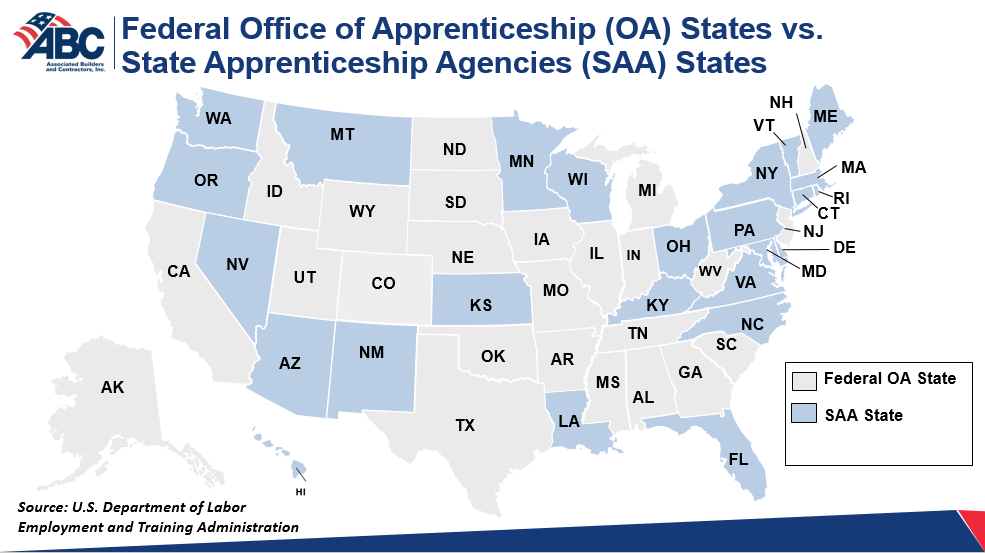
The Construction Industry Needs Lawmaker Support For An All-Of-The-Above Workforce Development Strategy
The truth is that government support of any type of workforce development is critical and appreciated, but the vast majority of upskilling and workforce development in the construction industry occurs outside of government-registered apprenticeship programs offered by union and nonunion stakeholders. In addition, an even greater amount of construction industry workforce development and upskilling occurs in programs not affiliated with union government-registered apprenticeship programs.
This is why government-mandated PLAs that require employers to use apprentices from union-affiliated and/or government-registered apprenticeship programs is problematic from a practical perspective. It locks out the vast majority of participants in registered programs and ignores the efforts of the workforce participating in industry-recognized apprenticeship programs. It also does little to address the workforce development issue facing the entire construction industry and instead steers work to participants in union-affiliated government-registered apprenticeship programs at the expense of everyone else, which give contractors affiliated with union apprenticeship programs an unfair competitive advantage.
The truth is that there needs to be a commitment by policymakers to an all-of-the-above workforce development strategy where workers and employers have freedom to choose the best way to provide value and rebuild America.
ABC, its 69 chapters and its 21,000+ members are doing their part to educate craft and management professionals using innovative and flexible learning models like just-in-time task training, competency-based progression, work-based learning and government registered apprenticeships to build a safe, skilled and productive workforce.
The reality is workforce development as a whole suffers when union-only and/or government-registered apprenticeship requirements are included in contract solicitations for taxpayer-funded public works construction projects.
Survey Shows Widespread Opposition to Government-Mandated Project Labor Agreements.
In addition, 98% of survey respondents said they were less likely to bid on a taxpayer-funded construction contract if the bid specifications required the winning firm to sign a PLA with labor unions, and 97% of survey respondents said a construction contract that required a PLA would be more expensive compared to a contract procured via free and open competition.
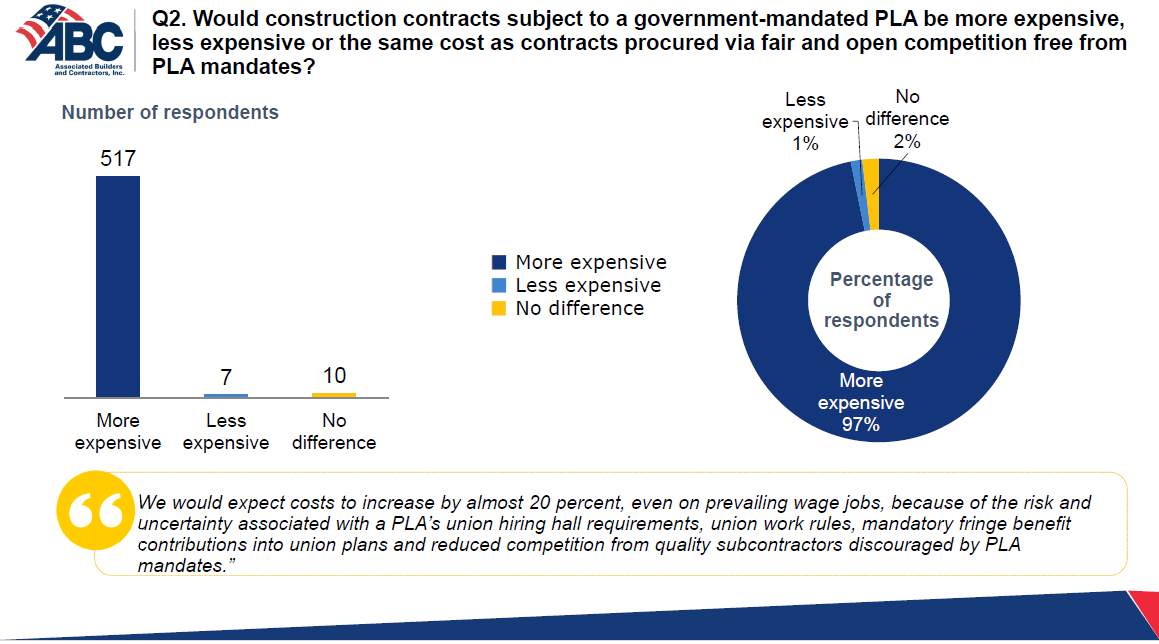
A clear majority of the more than 500 survey respondents affirmed that government-mandated PLAs are anti-competitive and discourage quality contractors and the 87.2 percent of U.S. construction workers who choose to not join a union from bidding and working on projects in their own communities, paid for by their own tax dollars. In fact, 97% of survey respondents said a PLA would result in worse local hiring outcomes for a project. In addition, almost 90% of respondents agreed that a PLA would decrease the hiring of women, veteran and disadvantaged business enterprises and construction workers, which have traditionally been unaffiliated with labor unions.
Currently, 24 states have adopted legislation or executive orders to ensure fair and open competition on state and local taxpayer-funded construction projects by restricting government-mandated PLAs and PLA preferences.
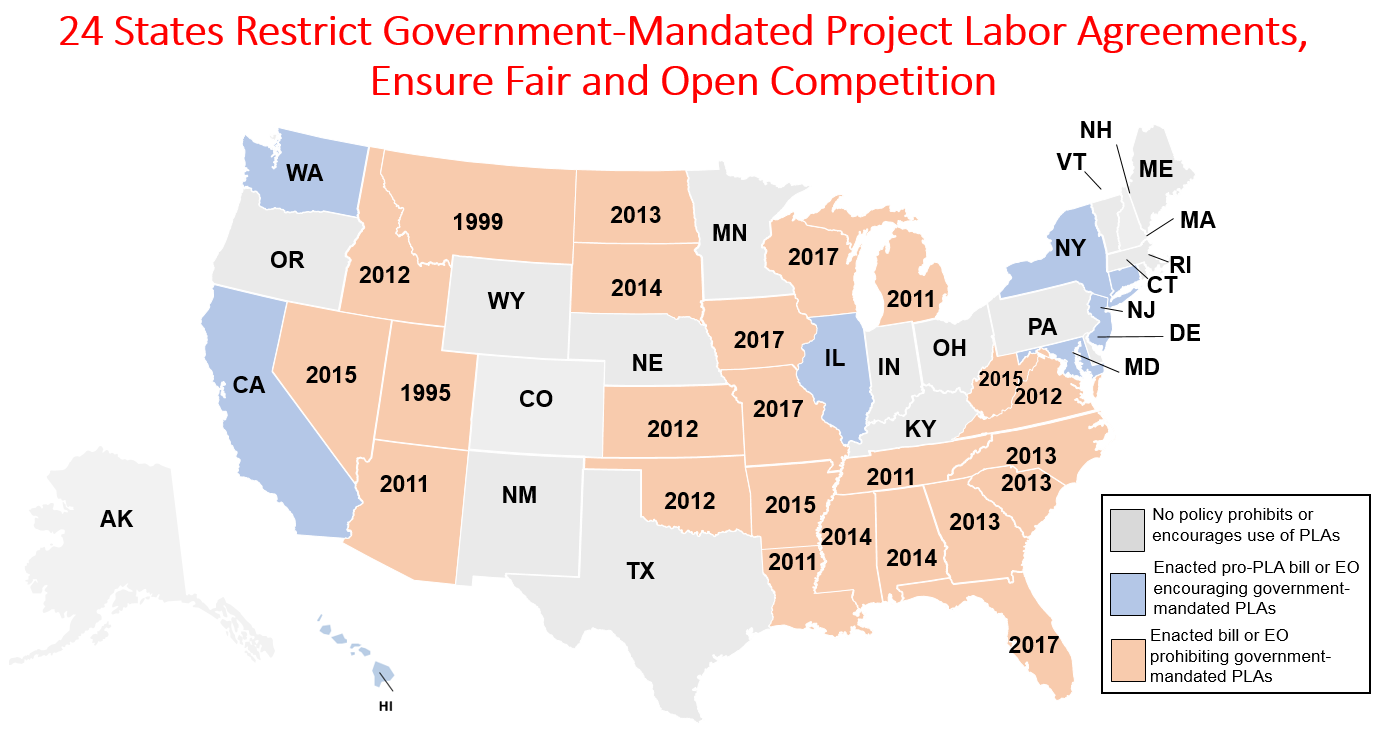
In February 2009, President Obama signed Executive Order 13502, which encourages federal agencies to mandate PLAs on large-scale federal construction projects exceeding $25 million in total value on a case-by-case basis, and permits states and localities to mandate PLAs on federally assisted projects. ABC has continually advocated to rescind the Obama-era policy and supports measures ensuring fair and open competition on federal and federally assisted construction projects that help taxpayers get the best possible product at the best possible price.
“It would be a real win-win for taxpayers and the U.S. economy if Congress and the Trump administration would create an inclusive policy so all Americans and all qualified companies can fairly compete to rebuild America’s infrastructure,” said ABC Vice President of Regulatory, Labor and State Affairs Ben Brubeck. “This common-sense reform would create a level playing field in the procurement of government construction contracts, increase competition, curb construction costs, help small businesses grow and improve America’s infrastructure.”
Note: Portions of this article have been republished from the January 30, 2019, edition of ABC Newsline. ABC has conducted similar membership surveys and most recently published results on member opinions towards government-mandated project labor agreements in October 2013.











